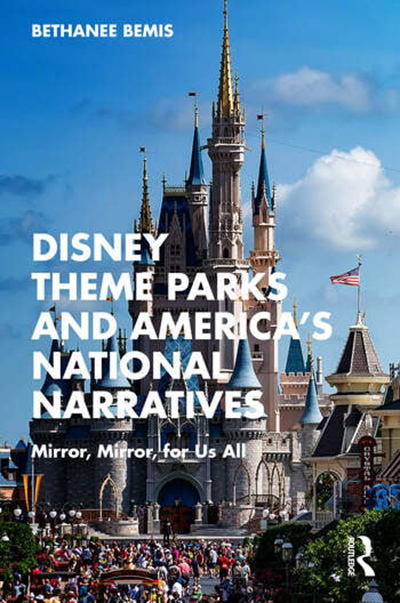Disney has become such a quintessential part of how the world views the United States of America, especially when it comes to its theme parks. Going back to the original Disneyland in 1955, places like Main Street, U.S.A. reveal an upbeat look at the classic American myth. Attractions like the Hall of Presidents, Great Moments with Mr. Lincoln, and The American Adventure have gone even further and presented a piece of this country’s history. In her excellent book Disney Theme Parks and America’s National Narratives: Mirror, Mirror, for Us All, Bethanee Bemis explores how the parks connect and tell our American stories.
I love this type of smart writing that takes the parks seriously but also comes from Disney fandom. Bemis is a Museum Specialist at the National Museum of American History at the Smithsonian. This book connects to the new exhibition, “Mirror, Mirror: Reflections of America in Disney Parks”, which opened this spring. Bemis is a curator on that exhibition and approaches Disney as a historian. She talks in the introduction about being part of the “Disney generation” as someone born in the late ’80s. I was born a decade earlier but think that term could expand to many adults today.
Bemis reveals how Disney’s status as an American institution arose by looking to the origins of Mickey Mouse’s popularity. Mickey’s role as the “everyman” goes beyond the character and connects to how Americans view themselves. This also fits with both the real life and legend of Walt Disney, who struggled before finding success. Bemis extends this approach to the popularity of Disney’s version of Davy Crockett played by Fess Parker. Works like the Crockett stories and other live-action Disney films shaped American folklore and how many looked fondly on the country’s history.
Connecting the Parks to Our History
I can’t get enough of books that explore deeper questions about Disney’s theme parks and themes. A perfect example is Vinyl Leaves: Walt Disney World and America by Stephen Fjellman. That book delved into how Disney presented history in the parks, particularly EPCOT, in 1992. Bemis covers similar territory but from a down-to-earth, insider’s perspective. Her confident writing takes us directly inside places like Frontierland, Liberty Square, and more through our senses.
Bemis’ descriptions elicit feelings about the sights, smells, and sounds of the parks that we love. She also goes beyond just covering expected lands that focus directly on distant historical events. A section on Tomorrowland notes its connections to JFK’s “new frontier” ideas in the 1960s. This book is a breezy 123 pages that’s a perfect read for a day at the beach or your next flight to Walt Disney World.
The final section examines the parks as markers of a changing American identity and a forward-thinking culture. This includes protests like the infamous Yippie “invasion” of Disneyland in 1970 and recent examples from a variety of political perspectives. Bemis also notes updates to The Jungle Cruise and Pirates of the Caribbean as ways that Disney has addressed diversity and gender depictions. These trends continue with the ongoing change from Splash Mountain to Tiana’s Bayou Adventure on both coasts.
Disney’s history isn’t perfect, and its positive and negative depictions connect to the country’s past and how it continues to evolve. In Disney Theme Parks and America’s National Narratives, Bemis explores connections between the American story and Disney’s parks that will continue to evolve in the future.
Purchase a copy of Disney Theme Parks and America’s National Narratives in the paperback or Kindle version on Amazon.
Related Book Reviews: Bethanee Bemis
At the Corner of Fantasy and Main: Disneyland, Midlife, and Churros by Matt Mason
Walt’s Apprentice: Keeping the Disney Dream Live by Dick Nunis
San Francisco’s 1939-1940 World’s Fair by Bill Cotter
This post contains affiliate links. Making any purchase through those links supports this site. See full disclosure.




Leave a Reply